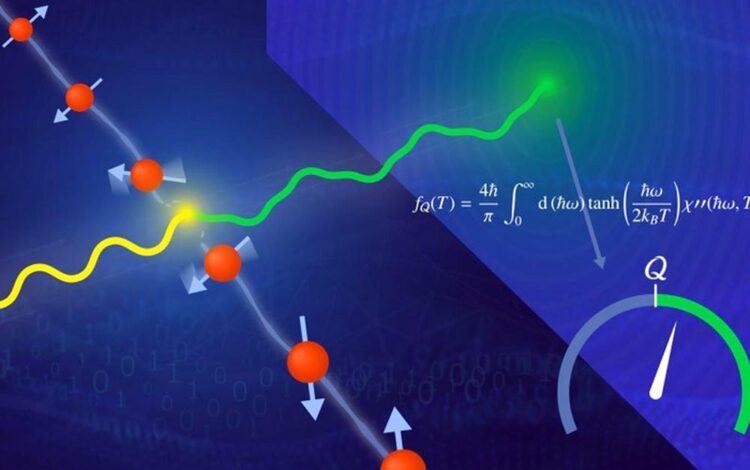Spilling the secrets of quantum entanglement

A material’s spins, depicted as red spheres, are probed by scattered neutrons. Applying an entanglement witness causes the neutrons to form a kind of quantum gauge capable of distinguishing between classical and quantum spin fluctuations.
Image courtesy of Nathan Armistead, Oak Ridge National Laboratory
Quantum technique accelerates identification of entangled materials.
The Science
Quantum materials behave in surprising ways because of quantum physics. For example, they can be superconductors, which can allow electricity to flow with no resistance. These materials could lead to completely new technologies. In an advance for quantum materials, scientists tested the ability of techniques called entanglement witnesses to accurately identify pairs of entangled magnetic particles. Entanglement is when one of these particles, or “spins,” mirrors another’s properties and behavior regardless of the distance between them. This research evaluated three entanglement witnesses. Of the three, quantum Fisher information (QFI) performed the best, routinely locating entanglement in complex materials. QFI also differentiated between true quantum activity and non-quantum activity that can appear quantum due to random thermal motion. In addition, the experiments confirmed that entanglement increases as temperature decreases.
The Impact
This work is the most thorough examination of QFI’s capabilities to date. It is also the first to apply the technique to massive solid materials by examining many pairs of entangled spins simultaneously. With QFI, scientists can more quickly identify entangled quantum materials such as quantum spin liquids, quantum magnets, and superconductors. These materials are ideal for applications such as data storage and computing. Incorporating QFI calculations into future neutron scattering experiments could help research teams characterize even more complex quantum materials.
Summary
Proving the presence of entanglement in one-dimensional spin chains—linear lines of connected spins within quantum materials—has historically been a major challenge in quantum information science. The team observed QFI tackling this challenge by applying the witness to neutron scattering experiments at the Spallation Neutron Source, a Department of Energy user facility. Because of their neutral charge and nondestructive nature, the neutrons provided valuable insights into the properties of two different spin chains. To validate their results, the researchers also ran computational simulations and analyzed data from older experiments conducted at the ISIS Neutron Source and the Institut Laue-Langevin.
Funding
This work was funded by the Department of Energy Office of Science, DOE’s Scientific Discovery through Advanced Computing program, Oak Ridge National Laboratory’s Laboratory Directed Research and Development program, the Quantum Science Center, the Center for Nanophase Materials Sciences, and the European Research Council under the European Union Horizon 2020 Research and Innovation Programme.
Media Contact
Michael Church
DOE/US Department of Energy
michael.church@science.doe.gov
Office: 2028416299
Original Source
https://www.energy.gov/science/ascr/articles/spilling-secrets-quantum-entanglement
All latest news from the category: Materials Sciences
Materials management deals with the research, development, manufacturing and processing of raw and industrial materials. Key aspects here are biological and medical issues, which play an increasingly important role in this field.
innovations-report offers in-depth articles related to the development and application of materials and the structure and properties of new materials.
Newest articles

A universal framework for spatial biology
SpatialData is a freely accessible tool to unify and integrate data from different omics technologies accounting for spatial information, which can provide holistic insights into health and disease. Biological processes…

How complex biological processes arise
A $20 million grant from the U.S. National Science Foundation (NSF) will support the establishment and operation of the National Synthesis Center for Emergence in the Molecular and Cellular Sciences (NCEMS) at…

Airborne single-photon lidar system achieves high-resolution 3D imaging
Compact, low-power system opens doors for photon-efficient drone and satellite-based environmental monitoring and mapping. Researchers have developed a compact and lightweight single-photon airborne lidar system that can acquire high-resolution 3D…





















